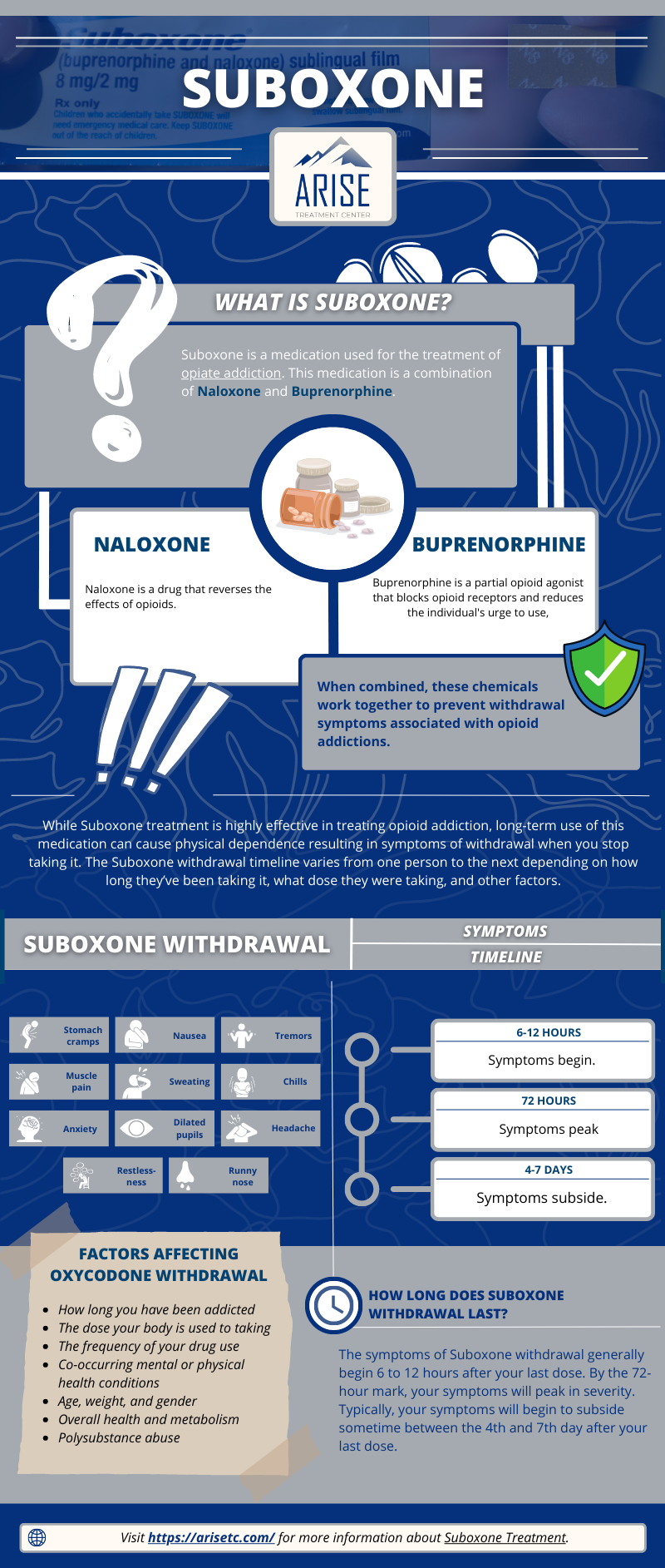Suboxone (buprenorphine/naloxone) is a prescription medication used to treat opioid dependence and addiction. While it is effective at treating opioid addiction, it can be physically addictive when taken long-term. Buprenorphine, one of the main drugs in Suboxone, is a partial opioid agonist that can produce similar withdrawal symptoms as other opioids if you stop taking it abruptly.
Suboxone withdrawal lasts longer than other forms of opioid withdrawal because it is a long-acting medication with a long half-life. Symptoms can vary in duration and intensity depending on how long you’ve been taking Suboxone and what dose your body is used to. However, you can avoid Suboxone withdrawal completely by working with your doctor to gradually reduce your dose. This is a method known as tapering and it can help you avoid withdrawal by letting your body slowly get used to lower and lower doses of buprenorphine.

Symptoms of Suboxone Withdrawal
Suboxone is a long-acting medication and withdrawal symptoms can last for up to a month. Common symptoms of Suboxone withdrawal include:
- Nausea
- Vomiting
- Digestive distress
- Indigestion
- Headaches
- Fever
- Chills
- Sweating
- Runny nose
- Difficulty concentrating
- Depression
- Anxiety
- Irritability
- Cravings
- Insomnia
- Muscle aches
- Body aches
- Dilated pupils
- Lethargy
- Tiredness
- Fatigue
How Long Does Suboxone Withdrawal Last?
If you quit taking Suboxone “cold turkey,” withdrawal symptoms may appear within 24 hours of your last dose. Symptoms usually peak within 72 hours. Physical symptoms usually last for about a week, but some psychological symptoms like anxiety, depression, irritability, and cravings can last for a month or longer.
The Suboxone withdrawal timeline varies from one person to the next based on factors such as:
- Duration of Suboxone use – Long-term Suboxone use will result in longer-lasting withdrawal symptoms.
- Dosage of Suboxone – Higher doses taken will cause more intense, longer-lasting symptoms of withdrawal.
- Age, weight, sex, and body composition – Personal health and lifestyle factors can affect the rate at which Suboxone is metabolized and, similarly, how long withdrawal lasts.
A Breakdown of the Suboxone Withdrawal Timeline
Suboxone has a half-life of 24-60 hours which is much longer than other opioids. Because of this long half-life, Suboxone stays in your system for a while, and it can take up to 24 hours for symptoms of withdrawal to appear.
Although the duration of Suboxone withdrawal may vary, most people follow a general timeline:
1-3 Days After Your Last Dose
Early symptoms of withdrawal may include fatigue, anxiety, discomfort, and mild flu-like symptoms. Close to the 72-hour mark, symptoms will peak and be at their worst, causing fever, body aches, vomiting, diarrhea, and more.
4-7 Days After Your Last Dose
After 4 days, peak withdrawal symptoms will start to subside. Most acute physical withdrawal symptoms subside within a week, but psychological symptoms continue to be intense during this time. Anxiety, irritability, and cravings are all expected.
2-4 Weeks After Your Last Dose
Most physical withdrawal symptoms should be gone after two weeks, but depression, anxiety, irritability, poor concentration, and cravings may persist.
4+ Weeks After Stopping Suboxone
Depression and cravings may persist for several weeks or months. Relapse is still a possibility during this time, so it’s important to continue using relapse prevention skills.
Coping With Suboxone Withdrawal
The best way to manage Suboxone withdrawal is to avoid it in the first place. You can avoid Suboxone withdrawal by taking your medication as prescribed and following your doctor’s instructions. When you are ready to stop taking Suboxone, your doctor will slowly wean you off the medication, allowing you to avoid withdrawal naturally.
Unfortunately, some people, particularly long-term Suboxone users, may still experience some unpleasant withdrawal symptoms while tapering off the medication. Such symptoms are usually mild and can be managed with symptom-specific medications (such as over-the-counter pain relievers for body aches and pain) and healthy lifestyle choices.
In addition to a slow taper, proper self-care and a healthy lifestyle will help lessen your symptoms. Some ways to cope with Suboxone withdrawal include:
- Consume a healthy, balanced, and nutritious diet
- Get plenty of restful sleep
- Stay hydrated
- Get some light exercise
- Keep yourself busy with something you enjoy
- Journal, meditate or do yoga
- Talk with your support group
When is Medical Detox Necessary?
If you have been abusing Suboxone or have been taking Suboxone that is not prescribed to you, you may be both physically and psychologically addicted to it. While physical dependence is normal when taking Suboxone long-term, psychological addiction is not, and this is when medical detox and a comprehensive addiction treatment program may be necessary.
A drug and alcohol detox center can help you taper off of Suboxone and start behavioral counseling so you can begin recovering from your addiction. Detox usually lasts less than a week, then you will transition to an inpatient or outpatient treatment program.
Find the Help You Deserve
Whether you’re interested in starting Suboxone treatment for your opioid addiction or you need help with Suboxone abuse, our team at ARISE Treatment Center is here to help. We provide a full-service drug and alcohol detoxification program, inpatient residential treatment, and outpatient rehab to help individuals in all phases of their addictions achieve lasting sobriety.
Don’t wait any longer to get the help you deserve. Call now to speak with one of our qualified admissions counselors.

